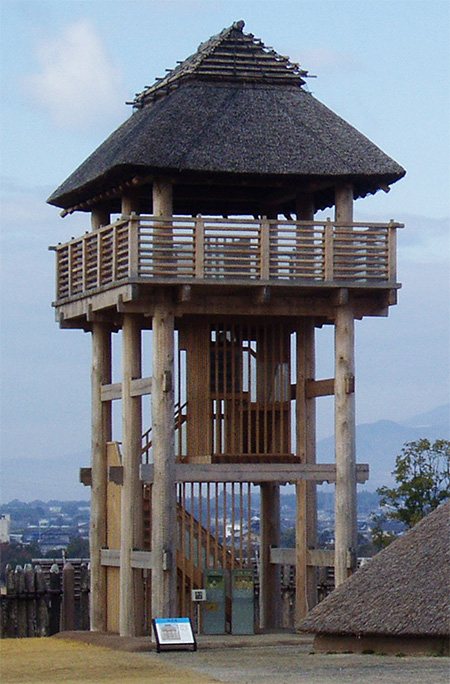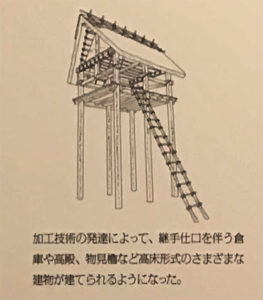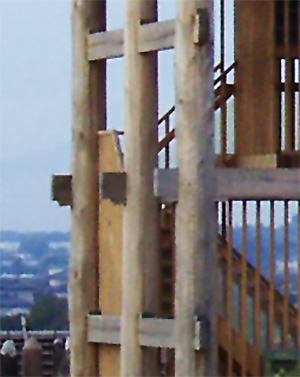


1万数千年続いた縄文時代は定住という人類生存形式、社会の形成と
画期的な時代だったと言えるのだと思います。
日本列島に渡ってきた現生人類は海を超えるのに木を伐採利用した船を使った。
四周を海で囲まれた列島の環境に適合した狩猟採集が漁業生業をもたらした。
食料獲得手段としては海生動物の採取、漁業が基本的な生業社会。
それまでの陸生動物主体の狩猟生活の場合でも一定の居住エリア認識はあったが、
獲物の移動にあわせてキャンプや洞窟などを転々としたのでしょう。
そういった暮らし方と対比すると船を使って海上を移動する、
陸生動物よりも「定置的」な海生動物漁業採取が生業化したことで、
主に海岸線地域竪穴住居暮らしが始まった。
そこでの実際の人間行動、定住の実態はどうだったか非常に興味深い。
というのは、生業の欠かせないツールとして船を使ったという点です。
定住というライフスタイルと移動の快適性が同時に獲得できたのだと思うのです。
大工の起源が船大工が先行し、家大工は定住後発生したとされる。
木工技術は船の造作が先で、そこでの蓄積技術が定住の建築に活かされた。
建築道具の上では前時代の石器時代に開発された石斧が主役だった。
現生人類がそれまでの先行の人類に対して優越していたのは、
この石器開発が飛躍的に発展したから、と言われるのが最近の説。
より鋭利であったり、有用性に即している素材開発が進んでいたのだと言われる。
世界的な生存競争が熾烈に繰り広げられていたのでしょう。
現生人類が他の人類との生存競争を勝ち抜く基本的生存戦略だったともいえる。
そう考えると木を伐採して建築架構することは人類レベルで決定的素因だったのかも。
石斧の発展によって船大工の技術レベルが革新されていったことで、
人類の世界全域への拡大が図られていった。
世界制覇した稀有な存在になれたのは、木を利用できる人類知が決定的だったか。
そういう縄文期を経て次にこの列島で革命が起こったのは、
やはり農耕定住と鉄器利用ということになる。
縄文はたしかに「定住革命」ではあったけれど、
ひとびとの生業は漁業であり、船による移動というライフスタイルが基本。
活発な列島社会内交流痕跡は多数発見される。かなり流動性の強い社会。
船による移動が石器時代以来の「伝統的」生き方だったのではないか。
農耕社会のような「一所懸命」型ではないのが生活伝統だったと思える。
それに対して弥生時代は石斧段階からより鋭利な鉄器利用が普及していった。
石斧段階とは利用可能な樹種が大きく変化しあらゆる樹種に拡張したとされる。
写真は吉野ヶ里の高層建築ですが、きのう見た縄文の木組みと違って
木材同志を相互に貫通させる技術が飛躍的に高まっている。継ぎ手仕口という
加工技術が本格的に始まってきている様子がわかるけれど、
その道具的進化が鉄器利用の拡大によって実現したとわかるのです。

吉野ヶ里遺跡では鉄を加工する専門の工房が集落の権力者のもとにあったという。
そういう権力者が鉄器の農器具も管理していたといわれる。
石斧に比べて道具としての有用性・合理性が異次元的に拡張された。
被支配層は集団的営農にもっぱら専念し「一所懸命」ライフスタイルに移行した。
鉄器は建築を高度化させたと同時に支配—被支配の社会関係を生み
同時に集落間での争闘、クニ同士の争い、戦争も常態化したと言われる。
吉野ヶ里では高床式の権力者建築も登場した展示が明示されている。
卑弥呼のような存在に対して拝跪するマネキン展示まであるのですね。
進化は同時に社会の格差を拡大する原動力にもなっていったのか。
しかしその結果として共同体の拡大、人口増加も進んでいった。
人類進化、技術発展の原動力があくなき人間の欲望であることも間違いないのでしょう。
English version⬇
[Wooden evolution process, Yoshinogari skyscraper / Japanese good house ㊳-2]
In the Jomon period, which lasted for more than 10,000 years, the form of human survival, the formation of society, was settled.
I think it was an epoch-making era.
The modern humans who came to the Japanese archipelago naturally used a ship that cut down trees to cross the sea.
The environment-friendly hunter-gatherer of the archipelago, which is surrounded by the sea on all four sides, has brought about a livelihood of fishing.
As a means of obtaining food, the basic livelihood society is the collection of marine animals and fishing.
Even in the case of terrestrial animal-based hunting until then, there was a certain recognition of the living area, but
Perhaps they moved around camps and caves as their prey moved.
In contrast to such a way of living, while traveling on the sea using a ship,
With the commercialization of marine animal fishing, which is more “stationary” than terrestrial animals,
It mainly means that the pit-house living in the coastline area has begun.
It is very interesting how the actual human behavior and the actual situation of settlement were.
That is, I used the ship as an indispensable tool for my livelihood.
I think I was able to acquire the lifestyle of settling and the comfort of traveling at the same time.
It is said that the origin of the carpenter was the ship carpenter, and the house carpenter occurred after the settlement.
As for woodworking technology, ship construction came first, and the accumulated technology there was utilized in the construction of settlement.
On the building tools, the stone ax developed in the Stone Age of the previous era was the leading role.
It was the fact that modern humans were superior to the previous humans.
The recent theory is that it is said that this stone tool development has developed dramatically.
It is said that the development of materials that are sharper and more useful is in progress.
The global competition for survival would have been fierce.
It can be said that modern human beings were the basic survival strategy to win the survival competition with other human beings.
Given that, cutting down trees and building structures may have been a decisive factor at the human level.
The development of the stone ax has revolutionized the technical level of ship carpenters.
The expansion of humankind to the entire world was planned.
Was it decisive for human beings to be able to use trees to become a rare animal species that conquered the world?
After the Jomon period, the next revolution in this archipelago was
After all it will be farming settlement and use of ironware.
The Jomon period was certainly a “settlement revolution,” but
People’s livelihood is fishing, and the basic lifestyle is to move by boat.
Many traces of active exchanges within the archipelago are found. A fairly fluid society.
Isn’t traveling by boat the “traditional” way of life since the Stone Age?
It seems that it was a tradition of life that it was not a “hard” type like an agricultural society.
On the other hand, in the Yayoi period, the use of sharper ironware became widespread from the stone ax stage.
It is said that the available tree species changed significantly at the stone ax stage and expanded to all tree species.
The photo shows a high-rise building in Yoshinogari, but unlike the Jomon woodwork I saw yesterday.
The technology for penetrating woods from each other is dramatically increasing. Called a joint
You can see that the processing technology has begun in earnest,
It turns out that the instrumental evolution was realized by the expansion of the use of ironware.
At the Yoshinogari ruins, it is said that there was a workshop specializing in iron processing under the authority of the village.
It is said that such a person in power also managed the agricultural equipment of ironware.
Compared to the stone ax, its usefulness and rationality as a tool have been expanded in a different dimension.
The controlled people have shifted to a “hard” lifestyle, devoting themselves exclusively to collective farming.
Ironware sophisticates architecture and at the same time creates a dominant-controlled social relationship
At the same time, it is said that the struggle between the villages, the struggle between Kuni, and the war have become normal.
At Yoshinogari, an exhibition that also features a stilt-type powerful building is clearly shown.
There is even an exhibition of mannequins that worships something like Himiko.
Did evolution also become a driving force for widening social disparities?
However, as a result, the community expanded and the population increased.
There is no doubt that the driving force of human evolution and technological development is the desire of human beings.
Posted on 8月 1st, 2021 by 三木 奎吾
Filed under: 住宅マーケティング, 住宅性能・設備







コメントを投稿
「※誹謗中傷や、悪意のある書き込み、営利目的などのコメントを防ぐために、投稿された全てのコメントは一時的に保留されますのでご了承ください。」
You must be logged in to post a comment.